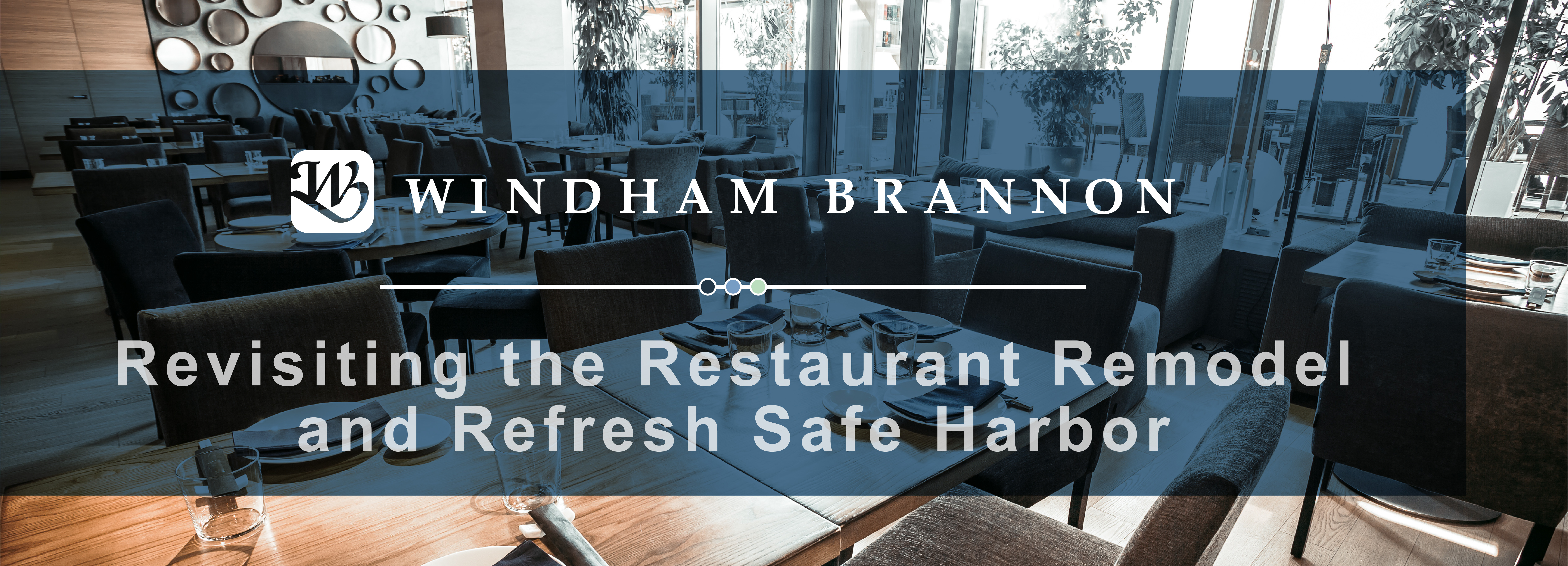Revisiting the Restaurant Remodel and Refresh Safe Harbor

Now that 100 percent bonus depreciation has begun to phase out effective Dec. 31, 2022, the remodel and refresh safe harbor method may be worth revisiting as part of a viable tax strategy for certain restaurants in 2023 and beyond.
SAFE HARBOR METHOD
The safe harbor method, included in Revenue Procedure (Rev. Proc.) 2015-56 and made effective for tax years beginning on or after Jan. 1, 2014, allows certain retail establishments and restaurants to deduct 75 percent of qualifying expenditures for remodeling or refreshing their buildings, while capitalizing the remaining 25 percent. This means that the 75 percent of qualified costs are treated as repair expenses under Section 162, while the 25 percent are treated as improvements under Section 263(a) and Section 263A. In 2017, Congress passed new provisions that allowed for 100 percent bonus depreciation, meaning that refresh and remodel projects capitalized under the safe harbor would have been eligible for immediate expensing. Bonus depreciation under these provisions has begun its phase-out effective Dec. 31, 2022, and the safe harbor is an option worth revisiting for restaurants to continue expensing on certain items while utilizing their cash flow for other projects. Instead of holding back funds in order to pay taxes, restaurants can instead use these funds to reduce their tax liability while continuing to improve and increase their footprint.
WHICH BUILDINGS QUALIFY FOR RESTAURANT REMODEL AND REFRESH PROJECTS?
Per the rules of the safe harbor, qualified buildings for remodel and refresh projects must be used primarily for preparing and selling food and beverages. This generally would exclude office headquarters and other non-traditional restaurants, such as casinos, caterers, hotels, country clubs and food trucks.
Any remodel and refresh projects should be on 20 percent or less of a qualified building to change, alter or update the physical appearance and/or layout for the purpose of one or more of the following:
- Update location appearance
- Improve efficiency in restaurant functions or products
- Conform to current building standards
- Standardize consumer experience if operating in more than one qualified building
- Update goods offered to consumers
- Update service offerings and presentations due to changes in demographics
Such projects may not include those that would apply to more than 20 percent of a qualified building, repainting or cleaning interior only, initial build-out of restaurant space, damage restoration, land improvements or updating a material defect. Also, leasehold improvement allowances are generally excluded.
ADOPTING THE SAFE HARBOR FOR RESTAURANTS
Taxpayers must also have applicable financial statements as defined in Regs. 1.263(a)-1(f)(4) and those who do not have audited financial statements are generally not eligible. Taxpayers who wish to adopt the safe harbor also must generally apply the rules to all existing buildings
Rev. Proc. 2015-56 also provides taxpayers with the guidance to secure consent in order to change their accounting method to accommodate the safe harbor. Changing to the safe harbor method is not permitted to claim partial disposition loss for an original qualified building under Regs. Sec. 1.165(i)-8(d)(2). Therefore, if the taxpayer wishes to change to the safe harbor method but made a partial disposition election for a prior tax year, the taxpayer is required to revoke the election either through an amended tax return or filing a Form 3115 to change the accounting method.
CONSIDERATIONS WITH YOUR ADVISOR
Taxpayers looking to adopt the remodel and refresh safe harbor should seek the help of their advisor to determine if the safe harbor fits their tax situation and strategy. Consider if you currently have enough qualified building property for a remodel and refresh to make the safe harbor a worthwhile change, as well as if the cost of the required financial statement audit is expected to be more or less than the anticipated remodel and refresh project of the restaurant. Windham Brannon’s team of experienced tax professionals can help taxpayers find answers to these questions and determine if the remodel and refresh safe harbor is right for their tax situation. For more information, contact your Windham Brannon advisor today, or reach out to Andrew Jones.
